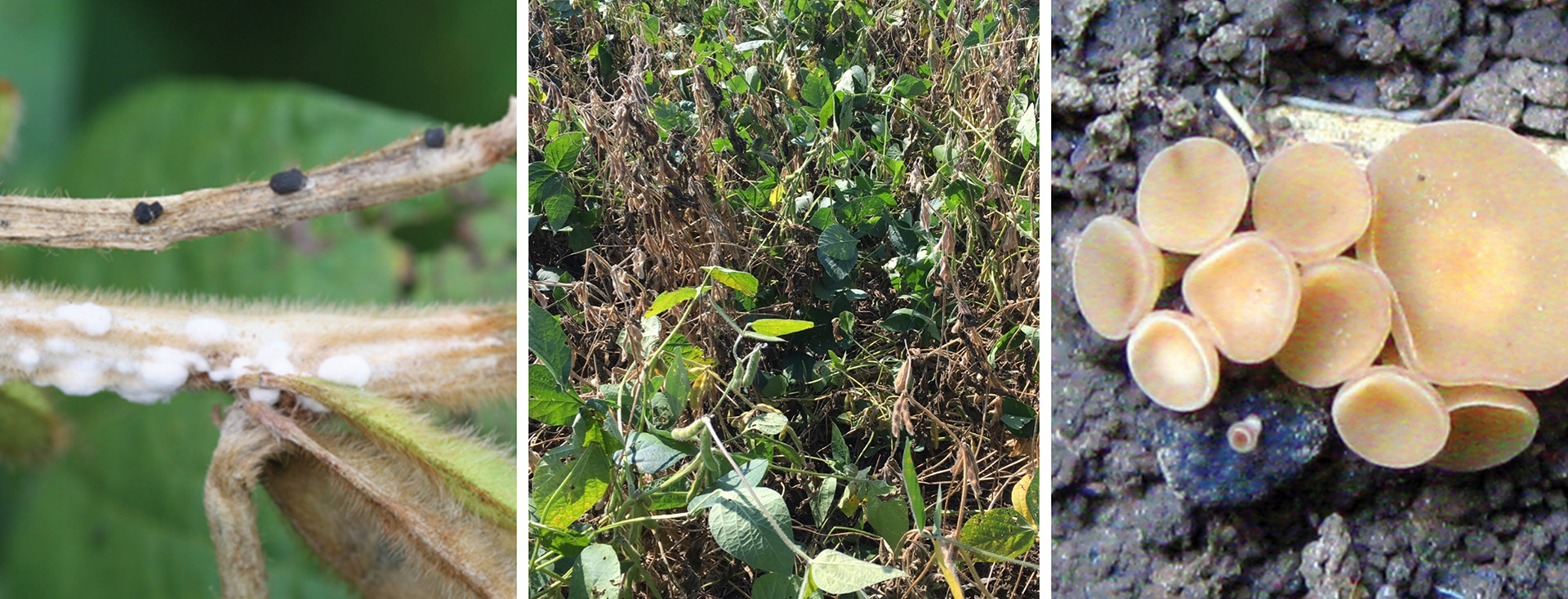
Symptoms of white mold include white, fluffy mycelial growth (far left); middle photo shows damage caused by white mold. Far right is apothecia. This mushroom-like structure appears on the soil where the germination of white mold begins. (Submitted photo)
Worrisome white mold a concern
June 23, 2022 | Kriss Nelson
Now is the time to scout soybean fields for white mold risk factors, soybean experts say.
“To manage white mold profitably, farmers must be proactive. By the time you see symptoms, it is often too late to implement a management practice,” says Scott Nelson, Iowa Soybean Association (ISA) senior field services program manager.
Symptoms of the yield-robbing disease typically shows up in the R3 to R6 stages as white lesions at the nodes of the soybean plant. As lesions spread along the entire stem, white, fluffy mycelial growth covers the infected area. Soon, black sclerotia begin to show.
Next, the soybean plant dies, and it is too late for treatment.
The disease cycle of white mold begins with the germination of the sclerotia at the soil surface. Sclerotia germinate to form mushroom-like structures called apothecia.
Nelson says starting now until the canopy closes, these mushroom-like structures may appear on the soil.
Daren Mueller, associate professor and Iowa State University Extension plant pathologist, says it can be challenging to identify apothecia in the field.
“But, everyone can check the weather, row closure and dig up field history to get an idea if white mold risk is elevated or not,” says Mueller. “All of these steps are indicators that apothecia could be present. Assessing risk is not fail-safe, but it can help.”
After some heavy bouts with white mold, Matt Danner, ISA farmer-member from Templeton in Carroll County, is starting to adjust how he raises soybeans to help combat the disease.
Danner says his soybean fields seem more susceptible to the disease due to his high fertility soils.
“White mold tends to grow in a high fertility environment, and we apply a lot of livestock manure from hogs, chicken and cattle,” says Danner. “We have high organic matter and just good soil fertility. We are doing everything we are supposed to do for 300-bushel corn and 80-bushel soybeans, and that makes white mold spores flourish.”
Although Danner was aware of the presence of white mold in some of his soybean fields last year, he didn’t realize how extensive it was until harvest.
Fields in Danner’s more eastern locations averaged 85- to 90-bushels to the acre, whereas the fields to the west that were infected with white mold yielded significantly lower, averaging 48- to 50-bushels to the acre.
In addition to relying on genetics and fungicides, Danner has reduced the population rate to allow more airflow into the soybeans.
He is also participating in on-farm research with a trial on a new version of the fungicide. Unfortunately, those acres were replanted due to hail, so it is unclear now if that trial will come to fruition.
In the future, he says he is considering switching to more corn-on-corn acres.
Understanding the risk of white mold
Things to consider if a soybean field has an increased risk of white mold are:
- Row spacing: narrower rows increase risk.
- What is the health of the soybean crop? “A good, healthy field with rows starting to close increases risk,” says Mueller.
- Soil moisture. “More days with moist soil increases risk,” says Mueller.
Producers are also encouraged to download the Sporecaster app to assist in making management decisions for white mold in soybeans.
Mueller says farmers may also visit the fungicide efficacy table to learn more about treatment opportunities if the risk is high.
As far as trying to manage against white mold, farmers can try choosing the most tolerant variety of soybeans and rotating crops, but Nelson says no soybean field is safe from the disease.
“White mold is appearing in areas we don’t expect,” he says. “It’s best to get boots on the ground and look; scouting should occur routinely.”
Back